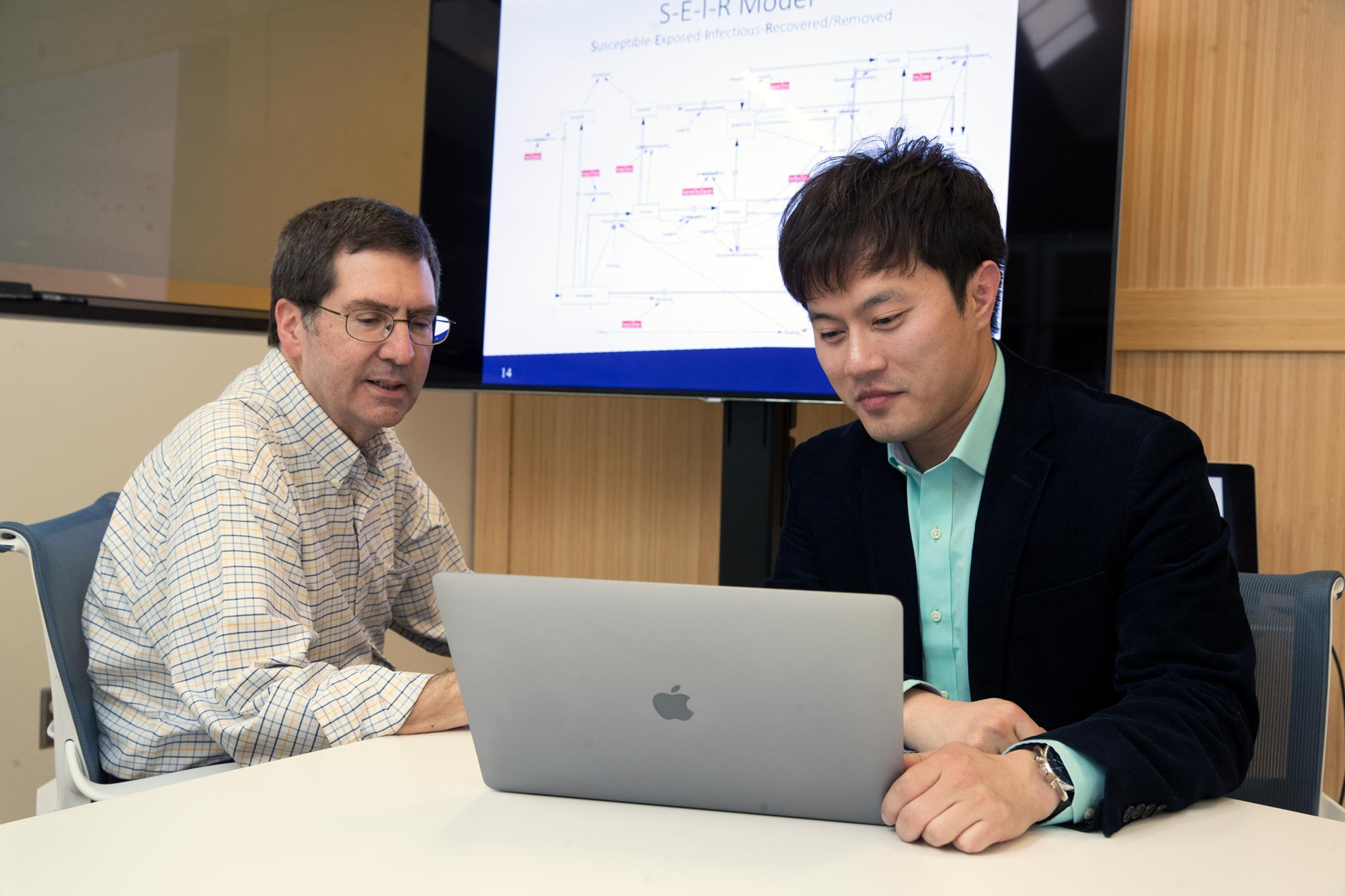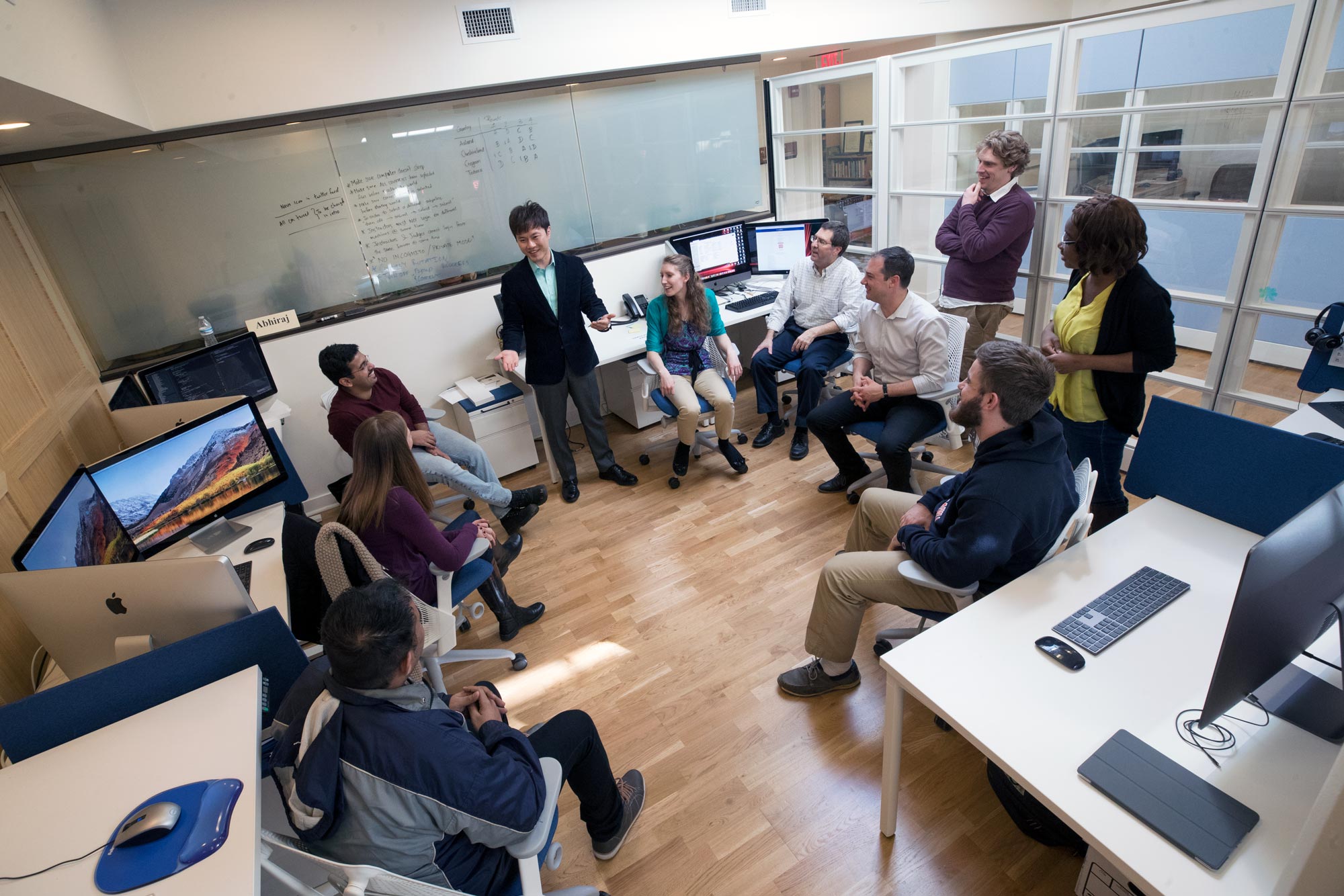Find the latest information on the University’s response to the coronavirus here.
A classroom simulation that took place two years ago at the University of Virginia’s Frank Batten School of Leadership and Public Policy is playing out for real in eerie fashion in the form of the current COVID-19 pandemic.
At that time, Noah Myung, a Batten assistant professor of public policy, and retired physician Dr. Andy Ortiz based their annual public policy simulation on a flu pandemic.
With a deadly flu virus spreading, world leaders – played by Batten students and others from around the world – needed to take immediate action.
Should they close their borders? Ban travel? Shut down schools? What about setting up a quarantine?
The students wrestled with the questions during a real-time crisis simulation, which was led by the Center for Leadership Simulation and Gaming at Batten and took place over the last weekend in February and the first weekend in March of 2018. More than 500 students from 155 different universities traveled to one of the 15 university locations around the world to compete using the simulation.
In just six months, Myung, who serves as Batten’s director of Center for Leadership Simulation and Gaming, and senior engineer Andy Ortiz created the first draft of what seemed like a modern-day version of the board game “Risk,” but now feels all too real.
The simulation, as well as other ones like it that Myung has run over the last few years, are perfect examples of the experiential learning Batten prides itself on.
UVA Today caught up with Myung to talk about the simulation – how it stands up to current reality, and the lessons learned.
Q. Is it a strange feeling that the simulation you and your team created has so many similarities to what is actually happening now?
A. Pandemics are horrible – they are at worst deadly and at best disruptive to our daily lives. However, when it comes to pandemics, it has never been a matter of “if” but “when?”
Unfortunately, we will face another pandemic outbreak even after COVID-19 and we have to do our best to learn to better manage these crises through research and experiences gained. It was our hope that participatory policy simulation based on a pandemic like ours would be used as one of the tools to help decision-makers to create informed courses of actions. Seeing similarities between what is happening right now to our simulation also helps to validate the work of our team in designing the simulation.
Q. Universities are telling students to stay home, major sports suspended their seasons after an NBA player tested positive for COVID-19 and people are even being told to not go to church. Were these the types of things that played out in your simulation?
A. Social distancing is a classic tool when it comes to managing an outbreak and it was definitely part of our simulation. Of course, the degree and the length of social distancing has different costs and effectiveness depending on the regions as well. Shutting down schools or restaurants for too short period of time, say one week, would not be enough to prevent the spread while still being disruptive to the society. In the other extreme, shutting down the schools and restaurants for multiple years would be extremely costly. Response needs to be proportional.
Furthermore, we now have the technology of providing temporary alternatives when we make some policy decisions. For UVA, we temporary decided to do online classes to minimize our impact instead of complete shutdown. This was not an option during the 1918 pandemic.
It is also important to understand that social distancing is another method of buying time similar to restricting travel, etc. The question is, what can you do to reduce the social and economic impact as well as the spread of the disease with the time gained with social distancing?

Myung and senior engineer Andy Ortiz, left, spent six months designing the simulation.
Q. What were some of the specific challenges your students faced in the simulation, and how do they compare to some of the ones our world leaders are facing now?
A. Students played roles of leaders of four different countries. The four countries, masked by fictitious names, were based on Chile, Seychelles, China and India. We chose these countries because they each had invoked policies to deal with epidemics and they were examples of different infrastructures as well as different economic and social settings: a tourism-based nation, a farming region, vs. a place where public transportation is the main mode of transit.
Students did not know where the disease would start and they were under a time pressure to make decisions. As they stared into the computer screen, not taking any action meant that they saw more people getting infected, and in turn, more people dying. If they decided to prevent traveling, while it slowed down the transmission of the diseases, it also had economic impact – bigger for a tourist-based country.
Our leaders are in a similar situation in that they are under time pressure to make the best decision they can with limited information. Not doing anything is not an option. And they have to create different degrees of actions based on the region in question. Every decision they make has cost and benefit associated with it. They are extremely difficult decisions that are not taken lightly. Those are some of the similarities that overlap between the simulation and what our decision-makers are facing right now.
Q. In examining how the actual pandemic has played out around the world and looking back at the simulation, what were some of the best responses by your students to the pandemic?
A. There were many learning opportunities via the computer portion as well as the non-computer portion of the simulation. If I were to summarize, we wanted students to learn how to make informed decisions using simulations and what-if analysis. The simulation is a policy simulation designed for policy students. That means, it was not loaded with epidemiology, but students learn to think about opportunity cost as well as process of making group decisions.
Next, we wanted students to learn that pandemic is a global issue and should not be tackled without coordinating with others. Coordination here means building a consensus to work toward a common goal and to learn from other group’s success and failures. That leads to the understanding that communication is extremely important during crisis management. …. Pandemic is a global issue and not solved by a single country.
Finally, we wanted students to learn about basic flu pandemic outbreak measures – e.g. not all facemasks are created equal and N95 masks are the ones to use.
Q. Have there been any decisions made by our world leaders that go completely against what you were trying to teach your students in the simulation?
A. I would not say there were decisions made that went against what we were trying to teach our students, but there were definitely actions taken by the leaders that were not included in our original simulation. For example, the Federal Reserve lowering the interest rate or utilizing quantitative easing to reduce the economic impact. I would love to include that feature into our future updates after COVID-19 passes and we collect more data on how different policies performed.
There are two things I would like to encourage, which were also encouraged in the simulation. First, taking proactive measures is important. Defensive actions, such reducing travel, may help slow down the spread of infection. Please, do not stop there, but use that time wisely to prepare supplies, vaccinations, gather and provide good information to the public, as well as create contingencies.
Second, have a good line of communication. Keep people informed with systematic updates. Personally, I have been impressed by UVA’s communications and fortunate to be led by President Ryan during this ordeal. I have seen different organizations failing to coordinate a coherent message, which only added to the chaos during this time of uncertainty. Communicate and coordinate efforts to minimize confusion and maximize effectiveness.
Q. Your simulation was part of a competition that had 76 judges, including representatives from the World Health Organization, Centers for Disease Control and Prevention and the Chinese Center for Disease Control and Prevention. In looking back at the event as a whole, are you hopeful that members of those organizations learned just as much from the exercise as the students themselves?
A. The judges played an important role in providing feedback and guidance to our students. We trusted those subject matter experts back then and we continue to trust our experts to guide us through the current event.
Although the experts did not directly participate in the simulation itself, I do hope that their experience in spending time with the students provided a new perspective, or maybe even elevated their thoughts on how to approach a pandemic crisis from a policy point of view.
Media Contact
Article Information
March 24, 2020
/content/qa-batten-professors-2018-global-pandemic-simulation-becomes-all-too-real

